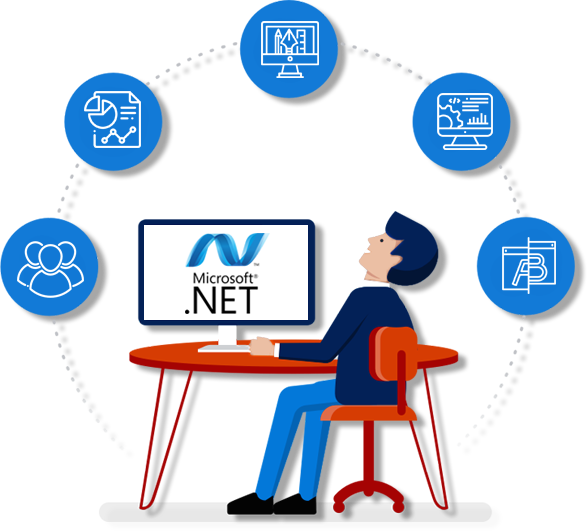Microsoft's .NET Framework: Overview, Evolution & How to Hire a .NET Developer
 Yukta Modi
Yukta ModiIn software development, the .NET Framework stands as a cornerstone, powering a vast array of applications and systems across multiple industries. As businesses increasingly seek to harness the potential of this robust framework, the demand for skilled .NET developers has surged. This introduction sheds light on the .NET Framework and its significance, particularly for those hiring .NET developers or dot net developers.
The .NET Framework, developed by Microsoft, is a comprehensive platform that simplifies software development by providing a structured environment for building, deploying, and running applications. This framework offers a rich class library, runtime environment, and tools that facilitate the creation of a broad spectrum of applications, ranging from web and desktop applications to mobile and cloud-based solutions.

Key Components of the .NET Framework
The .NET Framework comprises several fundamental components that collectively provide a robust foundation for developing and executing various types of applications. These components are essential building blocks for creating software solutions across different domains. Let's explore the main components of the .NET Framework:
Common Language Runtime (CLR): It is the heart of the .NET Framework. It's responsible for managing the execution of code written in various supported languages. The CLR handles tasks such as memory management, code execution, security, and exception handling. It provides an environment that ensures consistency, security, and performance across different languages.
.NET Framework Class Library: The Class Library is an extensive collection of pre-built classes and functions developers can use to perform standard tasks and operations. It abstracts complex programming tasks, enabling developers to focus on higher-level logic rather than low-level implementation details. This library covers a wide range of functionalities, from file operations to network communication.
Languages and Compilers: The .NET Framework supports multiple programming languages, including C#, VB.NET, F#, and more. Each language has its compiler that translates the source code into an intermediate language called Common Intermediate Language (CIL) or Microsoft Intermediate Language (MSIL). This intermediate code is then executed by the CLR.
ASP.NET (Web Applications): ASP.NET is a framework within the .NET ecosystem specifically designed for building web applications. It offers tools and libraries for creating dynamic, interactive, and scalable web pages. ASP.NET supports various technologies like Web Forms, MVC (Model-View-Controller), and Web API for building different types of web applications.
Windows Presentation Foundation (WPF): WPF allows developers to build robust desktop programs with visually appealing user interfaces. It makes it possible to create applications that are interactive, multimedia-rich, and have cutting-edge visuals, animations, and data-binding capabilities.
Windows Communication Foundation (WCF): WCF is a technology that facilitates building distributed and interoperable applications. It provides a framework for creating services that can communicate over different protocols like HTTP, TCP, and more. WCF simplifies the process of creating applications that communicate across various machines and platforms.
Windows Forms: Windows Forms is another technology for building desktop applications with graphical user interfaces. It uses a drag-and-drop approach to create user interfaces and is particularly suitable for building traditional Windows applications.
Entity Framework: The object-relational mapping (ORM) framework Entity Framework makes it easier to access and manage databases. Instead of writing raw SQL queries, it enables developers to work with databases using object-oriented notions.
These components collectively empower developers to create a wide range of applications, from web and desktop applications to services and more, leveraging the capabilities and tools provided by the .NET Framework.
Evolution of the Microsoft .NET Framework
The Microsoft .NET Framework has undergone a significant evolution since its inception, with each version introducing new features, enhancements, and improvements. Here's an overview of the evolution of the .NET Framework:
1. .NET Framework 1.0 (2002): The first version of the .NET Framework introduced the concept of managed code, the Common Language Runtime (CLR), and the .NET Framework Class Library. It supported languages like C#, VB.NET, and ASP.NET for web development. Windows Forms allowed developers to create desktop applications.
2. .NET Framework 1.1 (2003): This version brought performance improvements and bug fixes, refining the foundation laid by the initial release.
3. .NET Framework 2.0 (2005): A significant update introduced Generics, which allowed developers to write type-safe and efficient code. ASP.NET 2.0 brought enhanced web development capabilities. Visual Studio 2005, released alongside this version, provided better tooling support.
4. .NET Framework 3.0 (2006): Although labeled as a new version, it was more of an extension of the 2.0 framework. It introduced the Windows Presentation Foundation (WPF) for creating rich user interfaces, the Windows Communication Foundation (WCF) for building distributed systems, and the Windows Workflow Foundation (WF) for defining workflows in applications.
5. .NET Framework 3.5 (2007): This version added Language Integrated Query (LINQ) for querying data within .NET languages and support for ASP.NET AJAX, which enabled developers to build interactive web applications.
6. .NET Framework 4.0 (2010): Introduced support for dynamic languages through the Dynamic Language Runtime (DLR). Included improvements in the CLR, such as background garbage collection and improved security features. It also enhanced support for parallel programming through the Task Parallel Library (TPL).
7. .NET Framework 4.5 (2012): Introduced asynchronous programming support using the async and await keywords. It also included improvements to ASP.NET, WPF, and other components and enhanced integration with Windows 8 and Windows Server 2012.
8. .NET Framework 4.6 (2015): Focused on performance improvements and security enhancements. Introduced support for the HTTP/2 protocol and included updates to ASP.NET, WPF, and Entity Framework.
9. .NET Framework 4.7 (2017): This version continued to improve performance, security, and compatibility. It brought enhancements to Windows Forms, ASP.NET, and WCF.
10. .NET Framework 4.8 (2019): The final version of the traditional .NET Framework before it transitioned to .NET Core. It included various improvements and bug fixes across different components.
11. .NET Core and .NET 5 (2020): Microsoft introduced .NET Core as a cross-platform, open-source alternative to the .NET Framework. It provided improved performance, modularization, and compatibility with a broader range of operating systems. .NET 5, released in 2020, marked the beginning of unification efforts, combining .NET Core, Xamarin, and Mono into a single platform.
12. .NET 6 (2021): Building upon the foundation of .NET 5, .NET 6 introduced further unification efforts, improved performance, enhanced APIs, and increased support for cloud-native applications.
13. .NET 7 (Upcoming in 2022): Planned to continue the evolution with more features, improvements, and innovation.
It's important to note that the transition from the .NET Framework to .NET Core and now to .NET 5 and beyond reflects Microsoft's commitment to modernizing its development platform, making it more flexible, open-source, and capable of meeting the demands of modern application development.
Things To Remember While Hiring Dot Net Developers
When hiring .NET developers, it's crucial to consider various factors to ensure you find the right professionals who can effectively contribute to your projects and team. Here are some key things to remember while hiring .NET developers:
Technical Expertise: Look for candidates with a solid understanding of the .NET Framework, its core components, and related technologies. Assess their proficiency in programming languages like C# or VB.NET and their experience with relevant tools and frameworks.
Experience and Portfolio: Review the candidate's previous work and projects to gauge their practical experience. A well-rounded portfolio demonstrates their ability to develop a variety of applications, from web and desktop to mobile and more.
Problem-Solving Skills: .NET developers should be adept at analyzing complex problems and devising effective solutions. Assess their problem-solving skills through coding challenges or scenario-based questions during interviews.
Domain Knowledge: Depending on your industry or project requirements, consider candidates with experience in relevant domains, such as e-commerce, finance, healthcare, etc. Domain knowledge can expedite the development process and lead to more tailored solutions.
Communication Skills: Effective communication is vital for collaborative development. Ensure the candidates can articulate their ideas, discuss technical concepts clearly, and understand your project requirements.
Team Player: Assess their ability to work within a team environment. Developers should be able to collaborate with other team members, follow coding standards, and contribute positively to discussions and decisions.
Problem Identification: Beyond solving technical challenges, look for candidates who can identify potential issues or areas for improvement in existing codebases or development processes.
Version Control and DevOps: Familiarity with version control systems like Git and an understanding of DevOps practices can streamline the development workflow. Knowledge of continuous integration and deployment can also be beneficial.
Testing and Quality Assurance: Skilled developers emphasize testing and quality assurance. Inquire about their approach to writing unit tests, conducting integration testing, and ensuring the reliability of their code.
Adaptability and Learning: The tech landscape evolves rapidly. Seek candidates who demonstrate a willingness to learn new technologies, frameworks, and tools as needed.
Soft Skills: While technical prowess is vital, soft skills like teamwork, time management, and a proactive attitude contribute to a developer's overall effectiveness.
References and Recommendations: Contact references from previous employers or clients to gain insights into their work ethic, professionalism, and overall performance.
Cultural Fit: Consider whether the candidate's work style and values align with your company's culture. A good cultural fit can foster a harmonious and productive work environment.
Remote Work Skills: If remote work is a possibility, assess their ability to work effectively in a remote setting, including communication, time management, and self-discipline.
Trial or Assessment: Consider starting with a small coding task, a technical assessment, or a trial period to evaluate the candidate's practical skills and fit within your team.
By keeping these considerations in mind, you can make informed decisions when hiring .NET developers and build a strong team that contributes to the success of your projects.
Subscribe to my newsletter
Read articles from Yukta Modi directly inside your inbox. Subscribe to the newsletter, and don't miss out.
Written by

Yukta Modi
Yukta Modi
👨💻 Software Alchemist | Transforming Lines of Code into Digital Magic ✨ | Passionate Problem Solver | Lifelong Learner 📚 | Building the Future One Algorithm at a Time ⚙️ | Coffee Enthusiast ☕️ | Exploring the Boundaries of Possibility in the Digital Realm 🌐